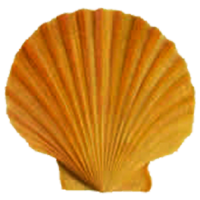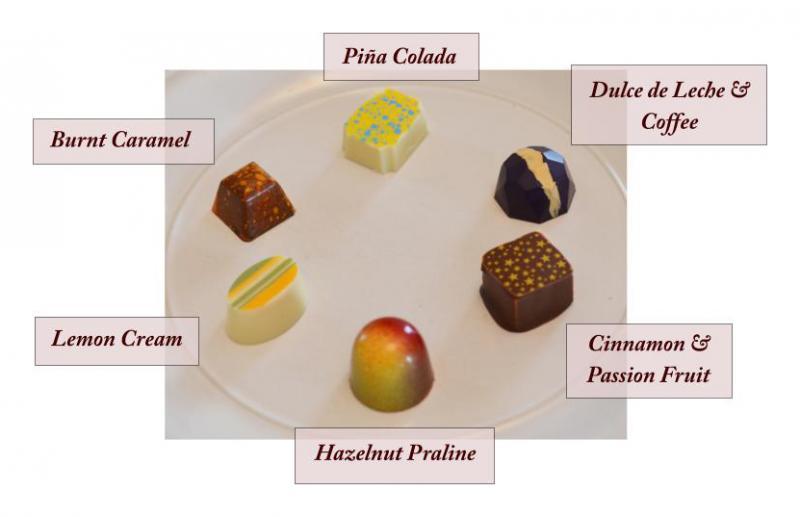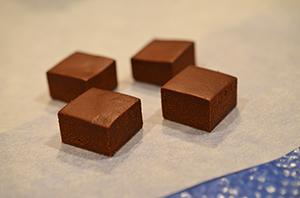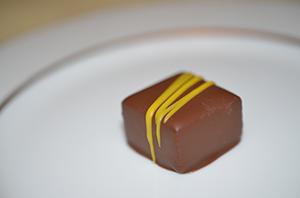-
Posts
2,397 -
Joined
-
Last visited
Content Type
Profiles
Forums
Store
Help Articles
Everything posted by Jim D.
-
Matthew, So how did the pina colada ganache turn out? Did you have the same experience I did--the ganache was very fluid at first, then became very firm? And did the pineapple flavor come through successfully? Jim
-
Matthew, As I understand it, there are two types of coconut oil, deodorized and non-deodorized. With pina colada, you want the coconut taste, so it's the second type. I am sure cream of coconut could be substituted or coconut purée. Yes, coconut oil is waxy--in fact, when it is cold, it acts just like a container of wax. But when mixed in a ganache, this quality disappears. As for the pineapple, I pressed the pineapple between paper towels and then processed it. I started to strain it, but all I was getting was liquid, so I just used it as it came from the food processor. It could be reduced, of course, but in my experiments I tried canned pineapple, and the flavor was significantly less, and that's what you would get if you cooked the fresh pineapple. In general, I have found that many of the commercial frozen purées have more of the consistency of juice, so I left in the pineapple pulp and don't have a problem with the texture it adds. I just returned from the party where the pina colada chocolates were served, and they seemed to be a big hit. I don't think the "pina colada" name hurts! Jim
-
After some of the items you have made, a compliment from you means a lot. For the pina colada, let me refer you to a recent posting of mine asking for assistance in understanding what was happening: http://forums.egullet.org/topic/63097-ganache-tips-techniques/page-17 -- it is post #492 and includes the ingredients. My results are not perfect, but I am still working on it. As Kerry Beal suggested in her reply to my post, the coconut oil is probably the key to the issue. Jim
-
I made some chocolates for the high school graduation party of a friend's daughter. The total for the batch was about 225 pieces. The hazelnut and the lemon were specially requested. The image is of a guide I made to tell guests what they were eating. Usually I try to decorate the outside to suggest what the ganache is, but in some of these I decided just to go for a festive look.
-
Ever since Tikidoc mentioned (on this forum) making a piña colada flavored ganache, I have been trying to come up with a recipe. I found one online and have been working with it (the author credits Peter Greweling for the recipe, but it is not in the Greweling book that I have--and I am suspicious as it calls for "white chocolate chips"). I am using white chocolate as a base and am aiming for a 2:1 ratio of chocolate to liquefiers (Greweling and Notter call for 2.5:1 for white chocolate, though many of their recipes do not adhere to this ratio). So here are the ingredients: Chocolate: 340g white chocolate, melted 34g cocoa butter, melted Liquefiers: 76g cream 90g pineapple purée 20g coconut rum Other Ingredient: 84g coconut oil Excluding the coconut oil from the calculations (as one does with butter in a regular cream ganache), the ratio is 2:1 (the cocoa butter is not in the original recipe, but I added it to bring the chocolate up to the amount needed without adding additional flavor). But when I finished the ganache and gave it time to firm up (this was a test), it started in a very liquid state but got very firm in a short time. So firm, in fact, that I was able to add more pineapple to get a better flavor, and it still was quite firm, probably more than one wants in a piped ganache. Can anyone explain what might have occurred to make this ganache so firm? Did the coconut oil do something to the mixture? (it was liquid when I added it). The flavor, by the way, was great, and if I can add more pineapple and rum, that would be a bonus. But I'm wondering if this was a fluke. Any insights would be welcome.
-
Thanks for that helpful chart and the insights. Do you have one of those meters to test Aw? I understand the impact of substituting invert sugar and sorbitol for glucose, but I'm not clear why reducing the chocolate would help. Can you explain? Thanks.
-
That recipe is quite something. I love the poster's note at the end: "This recipe takes some time." To put it mildly. It does sound intriguing, but I don't quite understand how the top crust works. If you drape it over a bowl and bake it "until deep golden brown," won't it be too convex in shape to fit over the apples without breaking?
-
I have been very interested in the report on this year's workshop. I don't know how accurate it is, but one of the impressions I have gotten from the posts is that there was quite a bit of overturning the tried-and-true chocolate rules. Some examples: Jean-Marie's method of mixing ganache which involved deliberately causing it to break, the washing of molds with soap in a dishwasher, the cleaning of molds with isopropyl, melting butter into a ganache rather than waiting to add it later, and using (as Kerry put it so cleverly--given the effect of this additive) "a shit load of sorbitol." I'm just wondering if those at the workshop got this same impression or if I just happened to notice these examples.
-

Spraying Chocolate: Equipment, Materials, and Techniques
Jim D. replied to a topic in Pastry & Baking
I asked about the brand because of the temperature control issue. I would want to find one that maintains temp (more or less) accurately. So many devices that have a temp control seem to offer just an approximation of what the dial says. -

Spraying Chocolate: Equipment, Materials, and Techniques
Jim D. replied to a topic in Pastry & Baking
Would you mind saying what brand/model of dehydrator you use? Thanks. -

How best to get the ice cream out of the Cuisinart ICE-20 Ice Cream Machine
Jim D. replied to a topic in Pastry & Baking
Excellent advice! -
Kerry, I had to laugh at the Jean-Marie/Valrhona method of mixing ganache--causing the fat to separate out deliberately. I don't know if you remember or not, but you and I discussed difficulties I had with Valrhona's Opalys white chocolate and its tendency to split in a ganache. So now when I encounter this supposed failure, I can just say it is the way it was meant to be! Jim Dutton
-

How best to get the ice cream out of the Cuisinart ICE-20 Ice Cream Machine
Jim D. replied to a topic in Pastry & Baking
Someone (can't recall whether it was on this forum or elsewhere) said the hard ice cream on the sides of the canister can be prevented by holding the dasher firmly against the edge of the canister. I briefly tried this once, but it did not seem to work. I suppose the issue of the firm layer occurs because there had to be a design compromise in not having the dasher fit so tightly against the canister that the canister would not turn easily. Thanks to paulraphael for the suggestion on cleaning the dasher into the canister. I have been spooning everything immediately into the storage container (which will go into the freezer shortly), but the container is at room temperature, so I am getting unnecessary melt. -

How best to get the ice cream out of the Cuisinart ICE-20 Ice Cream Machine
Jim D. replied to a topic in Pastry & Baking
Alas, I don't have any clever ideas, just complete sympathy. It is a very difficult task, made more so by the fact that I hear the stern voice of Cook's Illustrated warning me that every second the ice cream is not in the freezer, it is getting more icy. I find it particularly difficult to retrieve the ice cream that sticks to the outer container and that gets especially hard (and has a slightly unpleasant texture compared to the rest of the batch). I haven't seen any warnings about what utensils can be used, so I use metal spoons and scrapers to get that off. -
I must confess I didn't leave it longer than a few hours. My excuse: The top of the ganache is covered with a thick layer of Rice Krispies, pressed into the chocolate, so it seemed firmer than it was. By the time of the other two guitar attempts, I had learned to take a small knife and test the outside edges (where the slab is going to be trimmed off) to see just how firm the ganache is. Usually I wait a day. If it takes longer than that for a ganache to firm up, I consider it a recipe error (maybe a user error--but I wouldn't want to admit that). Notter's vanilla recipe calls for 495g of white chocolate + cocoa butter, with 310g of cream. That is not even close to a 2:1 ratio. It's a great ganache, but I will adjust the ratio next time.
-
It was a Wybauw recipe from his second volume (he calls it Orangina). It has a terrific flavor (unfortunately for my waistline, the edges left after a guitar cut are all too tempting). The second one that worked had two layers: Notter's pistachio plus his vanilla. Both were firm enough (just barely in the case of the vanilla) but not too firm. Interestingly the first ganache (the failure) was also Wybauw's, his recipe that includes Rice Krispies (if you can believe that). On reflection, I think I did not wait long enough for it to firm up.
-
To Edward and Pastrygirl: Thanks again for your assistance with use of the guitar. As you will see, I had success today (twice). I didn't realize what pleasure cutting a perfect cube could provide!
-
Thanks for those encouraging insights. The cleaning was so terrible today because the ganache was too soft--it got stuck even in places which the strings had not touched. But I will persevere.
-
Edward, Thanks for all those very helpful suggestions.
-
I recently splurged and bought a Dedy guitar (full size, single frame) and just completed my first attempt at cutting ganache. To summarize the experience succinctly: These are going to make fine truffles once I roll them and get them firm. In other words, it was a total failure. Since it would be a little awkward to ask to return a chocolate-covered guitar, I need to keep trying. So a few questions (I have read the entire thread to which I am adding this post): (1) As Ewald Notter suggests, the foot was not tempered chocolate, but was melted to around 115 F. or so. The idea is that it will not be as firm. I am terrified of breaking strings on the guitar, and even my "overtempered" foot seemed to take a lot of effort to cut through it. Is this normal? How fragile are the strings? For those who have broken some, what sort of ganache did it take to do so? (2) This is not the fault of the guitar but of the ganache recipe (even the recipes of world-famous chocolatiers are not foolproof). It looked and felt firm enough, but when the strings went through it, it squished out of shape (therefore the truffles). Again, my concern was that the strings might break; otherwise I would have paid more attention to the consistency. Can someone suggest a Greweling or Notter recipe that is known to work with a guitar? (3) Where should the slab be placed? Right against the raised edge (the edge at the "front" of the guitar)? In this thread Kerry Beal suggested, I think, that it is better to place it toward the "back" in order to get better leverage. (4) Cleaning the guitar is a pain. What do people use to remove ganache that gets lodged between the slots in the base? Any assistance will be greatly appreciated. If the situation doesn't improve, I will be back using my hot knife and ruler and will have a Dedy guitar for sale!
-
"Despite heat and humidity, I got lucky on the tempering...." I was intrigued by that statement. I live about 100 miles west of you and have been having terrible issues tempering lately (and we're supposed to be in the temperate Shenandoah Valley). Humidity is my best guess since the same bags of white and dark chocolate worked fine a month or so ago. Today I've got the AC going full blast, but still the dark choc. (Felchlin Maracaibo) thickened up within a very short time. I'm at my wit's end. Your chocolates for Vegas are beautiful, and the fillings sound very interesting. I had to look up "durian." It's a bit off-putting when Google says about a fruit: "Despite its fetid smell, it is highly esteemed for its flavor." So you found durian in Richmond? Jim
-
(1) About the coconut filling: What kind of chocolate do you use for molding? In the recipe for a similar filling, Jean-Pierre Wybauw (in his second ganache book) says: "Since the coconut fat, when coated with dark chocolate, can cause fatbloom within a relatively short period, it is recommended to coat this filling with milk chocolate." Peter Greweling (in Chocolates and Confections) may have insights useful to you in his discussion of "eutectics": "When coconut fat with a 33C/92F melting point is combined with cocoa butter, which melts at around 34C/94F, the resulting mixture melts well below the temperature of either of the component fats...." (p. 343)--thus providing the "meltaway" effect of a solid but quickly melting confection. Perhaps that is what you are getting when you mix cocoa butter (in the white chocolate) with the coconut fat. If that is the case, it is not clear whether adding cocoa butter would help your situation, though it might be worth experimenting. (2) About the cardamom ganache: I have used Wybauw's recipe (from the same book as above)--which sounds much the same as your recipe, including the use of invert sugar. It was very popular and lasted at least a month with no sign of spoilage. I've never heard that warning about mixing cardamom and cream. How soon did your filling go off?
-
Beautifully decorated. I look forward to seeing the results of your next experiments. If you don't mind telling, how did you get that mirror effect in the photograph? Are the pieces sitting on glass or ... ?
-
My impression from reading what others have said on eGullet is that they tend to use the phrase "best by" rather than "use by" on their products. That gives you a cushion. As I previously wrote in this thread, I became alarmed when some recipients of my chocolates told me how long they stretched out the eating process. As if to underline the issue, yesterday I got a thank-you note from a recipient, informing me that he had just finished the last piece. The problem is that because of an emergency situation, I had to ship the Easter batch on April 7, so that last piece was more than a month old--since, of course, I had to begin making the pieces well before April 7. There is nothing one can do about such situations, but knowing about them does give perspective on shelf life. And, as I said earlier, I am definitely including a "wrap tightly and refrigerate if you keep them longer than two weeks" statement with chocolates. What more can one do? Even corporations like Kraft can't make people put the mayo in the fridge.
-
Congratulations on this new step in your career. I recall your excitement from your recent popup and so am not surprised at this development. Shelf life is a topic I have been concerned about of late--especially once I learned how long some recipients of my chocolates keep them! Jean-Pierre Wybauw's third volume on ganaches deals with the subject at length. I include a guide with each box explaining what the fillings are--and an ever-more-restrictive "best by" statement and warning that if the confections are going to be kept longer than two weeks, they should be wrapped well and refrigerated (on the theory of better a little condensation than a funeral!). I have kept some chocolates for over a month and have never encountered mold, but others on eGullet have found mold, and the taste certainly suffers. Here are links to a few discussions on eGullet about shelf life, proper ganache formulation, preserving chocolates, etc.: http://forums.egullet.org/topic/147590-puréed-fruit-as-chocolate-filling-water-content/ http://forums.egullet.org/topic/63097-ganache-tips-techniques/ http://forums.egullet.org/topic/94070-shelf-stableshelf-life-of-truffles/ http://forums.egullet.org/topic/129934-shelf-life-of-homemade-confections/ http://forums.egullet.org/topic/114561-balancing-your-ganache-recipes-20/ You can find more discussion of the topic on www.thechocolatelife.com -- do a search under Forums. Jim Shelf life is a topic I have been thinking about quite a bit lately. The ultimate solution is to purchase an aW meter to test all your confections, but--as you probably know--those devices are quite expensive.





